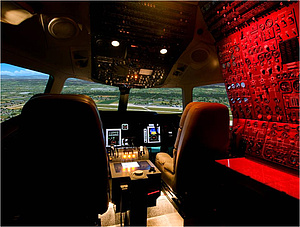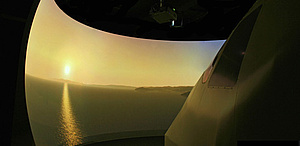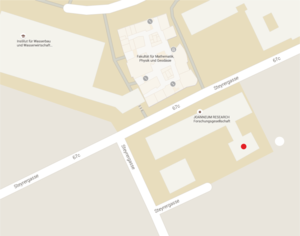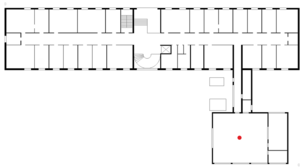Widebody Aircraft
Both of the simulators are fixed base and equipped with a wide-angle projection vision system with 7m screen diameter and 3m screen height providing a horizontal field of view of 150 and 180 degrees.The widebody aircraft simulator uses the hull of an ex-DC 10 simulator, and its interior has been remodelled to state-of-the-art avionics. Its ample cockpit is perfectly suited for teaching, research and development, since it provides easy access to both pilot seats and allows installation of additional research equipment.
The seat of the former flight engineer is perfectly suited to be used by an observer during experiments. The simulator is driven by a highly modular software that simulates generic flight dynamics, engines, particular aircraft systems, and the radio navigation system. Flight dynamics is available for a generic widebody aircraft as well as a small business jet, in particular a Cessna Citation V.
The avionics at the main panel consists of two fully functional replicas of Collins ProLine 21 primary flight displays (PFD) and three replicas of Collins ProLine21 multi function displays (MFD). A set of independent standby instruments is also located at the front panel. Furthermore, there is a replica of the Honeywell MK VIII enhanced ground proximity warning system (EGPWS) installed, which uses the public available high resolution SRTM database for the terrain display and the look-ahead warning algorithm. A conventional TCAS II is used for generating traffic warnings dependent of simulated targets. PFD and MFD both have the capability of displaying a simulated weather radar image. Above the front panel and below the glareshield a mode control panel is installed, that allows programming vertical and lateral modes of the flight director and autopilot control. Radio tuning can be performed by using the FMS or simulated radio control heads. The center panel hosts two replicas of the Universal UNS-1 flight management system, whose routes can be displayed on the MFDs with each MFD having the possibility to be switched to any FMS source. In addition, a moving map featuring flight planning, terrain, traffic, and weather overlay is also installed for evaluation purposes. Both FMS as well as the EGPWS have access to a Jeppesen ARINC database that is kept current with its 28-day cycle.
The avionics software is the same as installed in various certified flight simulators up to full-flight level A used for pilot training, one of them being operated by a flight training organisation. TU Graz has full access to the software, albeit strictly limited to research purposes. The radio navigation system includes a terrain model to simulate loss of signal due to obstruction by terrain. All simulator modules are installed at various computers and interconnected via Ethernet. A data logger is available to record any selected subset of data circulating in the simulator network. Replay of such data can be used for situation analysis.
The seat of the former flight engineer is perfectly suited to be used by an observer during experiments. The simulator is driven by a highly modular software that simulates generic flight dynamics, engines, particular aircraft systems, and the radio navigation system. Flight dynamics is available for a generic widebody aircraft as well as a small business jet, in particular a Cessna Citation V.
The avionics at the main panel consists of two fully functional replicas of Collins ProLine 21 primary flight displays (PFD) and three replicas of Collins ProLine21 multi function displays (MFD). A set of independent standby instruments is also located at the front panel. Furthermore, there is a replica of the Honeywell MK VIII enhanced ground proximity warning system (EGPWS) installed, which uses the public available high resolution SRTM database for the terrain display and the look-ahead warning algorithm. A conventional TCAS II is used for generating traffic warnings dependent of simulated targets. PFD and MFD both have the capability of displaying a simulated weather radar image. Above the front panel and below the glareshield a mode control panel is installed, that allows programming vertical and lateral modes of the flight director and autopilot control. Radio tuning can be performed by using the FMS or simulated radio control heads. The center panel hosts two replicas of the Universal UNS-1 flight management system, whose routes can be displayed on the MFDs with each MFD having the possibility to be switched to any FMS source. In addition, a moving map featuring flight planning, terrain, traffic, and weather overlay is also installed for evaluation purposes. Both FMS as well as the EGPWS have access to a Jeppesen ARINC database that is kept current with its 28-day cycle.
The avionics software is the same as installed in various certified flight simulators up to full-flight level A used for pilot training, one of them being operated by a flight training organisation. TU Graz has full access to the software, albeit strictly limited to research purposes. The radio navigation system includes a terrain model to simulate loss of signal due to obstruction by terrain. All simulator modules are installed at various computers and interconnected via Ethernet. A data logger is available to record any selected subset of data circulating in the simulator network. Replay of such data can be used for situation analysis.



